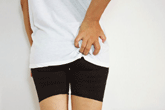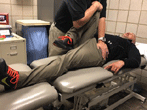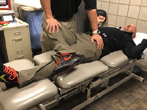 The
sacroiliac joint (SIJ) is a synovial joint that garners a
lot of controversy as it can share common pain patterns with
multiple conditions at the spine (stenosis, DDD, herniated
disc, etc.), hip (FAI, OA, AVN, etc) and pelvis (glut tear,
piriformis, pelvic floor) (1). Given the shared pain
patterns involving the SIJ and the structures mentioned
previously, obtaining a SIJ pain diagnosis can prove to be
challenging. Diagnosing SIJ pain involves obtaining a
detailed subjective history which is positive, conducting a
thorough lumbar spine & hip exam to help rule out issues at
these structures, obtaining positive provocative test
results for the SIJ and achieving a positive response to an
intra-articular injection (1). Often times SIJ ROM and
position testing are performed in the physical exam as well
but have been found to be unreliable (1, 2, 3). The chart
provided below details common pain referral patterns for the
lumbar spine, hip and SIJ (1, 4, 5).
The
sacroiliac joint (SIJ) is a synovial joint that garners a
lot of controversy as it can share common pain patterns with
multiple conditions at the spine (stenosis, DDD, herniated
disc, etc.), hip (FAI, OA, AVN, etc) and pelvis (glut tear,
piriformis, pelvic floor) (1). Given the shared pain
patterns involving the SIJ and the structures mentioned
previously, obtaining a SIJ pain diagnosis can prove to be
challenging. Diagnosing SIJ pain involves obtaining a
detailed subjective history which is positive, conducting a
thorough lumbar spine & hip exam to help rule out issues at
these structures, obtaining positive provocative test
results for the SIJ and achieving a positive response to an
intra-articular injection (1). Often times SIJ ROM and
position testing are performed in the physical exam as well
but have been found to be unreliable (1, 2, 3). The chart
provided below details common pain referral patterns for the
lumbar spine, hip and SIJ (1, 4, 5).
| Spinal Stenosis (1, 4) |
Isolated Hip
Pathology (1, 4) |
Sacroiliac Joint
(1, 5) |
| Buttock
Common | Buttock
Pain (71%) |
Buttock, PSIS (94%) |
| Groin Uncommon (except L1,
L2) |
Thigh and Groin (55%) |
Groin Not Uncommon (14%) |
| Lower Extremity Common |
Knee or Below (47%) |
Lower Extremity Common (28%) |
| Lateral Hip - Common |
Lateral Hip - Common |
Lateral Hip and Thigh Common |
| Lumbar Region Common |
Lumbar Pain Uncommon |
LLower Lumbar Region (72%) |
In this article we will review the SIJ provocative tests
involved with diagnosing SIJ pain. Laslett et al (1, 2) describes
five SIJ provocative tests: 1) Distraction
2) Thigh Thrust
3) Compression 4) FABER
5) Gaenslen’s Maneuver. When these 5
provocative tests are performed in combination they are
proven to have a high degree of sensitivity and specificity
(1. 2).
The thigh thrust and compression test were found to be the
most sensitive and the distraction test the most specific
with the highest positive predictive value (1, 2). When
interpreting the results for the SIJ provocative tests (1,
2):
0 Positive Tests = Ruled Out
1 Positive Test = Suspicion
2 Positive Tests = Fair Confidence
3-5 Positive Tests = High Confidence
In addition, if centralization of pain is not achieved
during a McKenzie evaluation of repeated movements/sustained
positions specificity increases for a SIJ pain diagnosis (1,
2).
Distraction (1, 2)
 With the patient in supine a
vertically oriented pressure is applied to the anterior
superior iliac spinous (ASIS) processes directed
posteriorly, distracting the SIJ.
With the patient in supine a
vertically oriented pressure is applied to the anterior
superior iliac spinous (ASIS) processes directed
posteriorly, distracting the SIJ.
Thigh Thrust (1, 2)
 With the patient in supine,
holding the hip flexed to 90 degrees and stabilizing the
opposite ASIS with the other hand, a vertically oriented
force is applied through the line of the femur directed
posteriorly, producing a posterior shearing force at the
SIJ.
With the patient in supine,
holding the hip flexed to 90 degrees and stabilizing the
opposite ASIS with the other hand, a vertically oriented
force is applied through the line of the femur directed
posteriorly, producing a posterior shearing force at the
SIJ.
Compression (1, 2)
 With the patient in sidelying
a vertically directed force is applied to the iliac crest
directed towards the floor compressing the SIJs.
With the patient in sidelying
a vertically directed force is applied to the iliac crest
directed towards the floor compressing the SIJs.
FABER (Flexion, Abduction/External
Rotation) (1, 2)
 With the patient in supine
cross the same side foot over the opposite side thigh while
stabilizing the opposite ASIS and apply a force on the same
side knee of the patient exaggerating the motion of hip
flexion, abduction and external rotation resulting in a
tensile force on the anterior aspect of the SIJs.
With the patient in supine
cross the same side foot over the opposite side thigh while
stabilizing the opposite ASIS and apply a force on the same
side knee of the patient exaggerating the motion of hip
flexion, abduction and external rotation resulting in a
tensile force on the anterior aspect of the SIJs.
Gaenslen
(1, 2)
 Wfont>ith the patient in supine near
the edge of the table, the patient is asked to flex the
opposite hip grasping their knee which locks the SIJ in
position. The near leg is then slid of the table and an
extension force is applied while a flexion force is applied
simultaneously through the opposite leg resulting in a
torsional stress on the SIJs.
Wfont>ith the patient in supine near
the edge of the table, the patient is asked to flex the
opposite hip grasping their knee which locks the SIJ in
position. The near leg is then slid of the table and an
extension force is applied while a flexion force is applied
simultaneously through the opposite leg resulting in a
torsional stress on the SIJs.
Last revised: June 29, 2018br>
by Chai Rasavong, MPT, COMT, CMTPT, MBA

 The
sacroiliac joint (SIJ) is a synovial joint that garners a
lot of controversy as it can share common pain patterns with
multiple conditions at the spine (stenosis, DDD, herniated
disc, etc.), hip (FAI, OA, AVN, etc) and pelvis (glut tear,
piriformis, pelvic floor) (1). Given the shared pain
patterns involving the SIJ and the structures mentioned
previously, obtaining a SIJ pain diagnosis can prove to be
challenging. Diagnosing SIJ pain involves obtaining a
detailed subjective history which is positive, conducting a
thorough lumbar spine & hip exam to help rule out issues at
these structures, obtaining positive provocative test
results for the SIJ and achieving a positive response to an
intra-articular injection (1). Often times SIJ ROM and
position testing are performed in the physical exam as well
but have been found to be unreliable (1, 2, 3). The chart
provided below details common pain referral patterns for the
lumbar spine, hip and SIJ (1, 4, 5).
The
sacroiliac joint (SIJ) is a synovial joint that garners a
lot of controversy as it can share common pain patterns with
multiple conditions at the spine (stenosis, DDD, herniated
disc, etc.), hip (FAI, OA, AVN, etc) and pelvis (glut tear,
piriformis, pelvic floor) (1). Given the shared pain
patterns involving the SIJ and the structures mentioned
previously, obtaining a SIJ pain diagnosis can prove to be
challenging. Diagnosing SIJ pain involves obtaining a
detailed subjective history which is positive, conducting a
thorough lumbar spine & hip exam to help rule out issues at
these structures, obtaining positive provocative test
results for the SIJ and achieving a positive response to an
intra-articular injection (1). Often times SIJ ROM and
position testing are performed in the physical exam as well
but have been found to be unreliable (1, 2, 3). The chart
provided below details common pain referral patterns for the
lumbar spine, hip and SIJ (1, 4, 5).  With the patient in supine a
vertically oriented pressure is applied to the anterior
superior iliac spinous (ASIS) processes directed
posteriorly, distracting the SIJ.
With the patient in supine a
vertically oriented pressure is applied to the anterior
superior iliac spinous (ASIS) processes directed
posteriorly, distracting the SIJ.  With the patient in supine,
holding the hip flexed to 90 degrees and stabilizing the
opposite ASIS with the other hand, a vertically oriented
force is applied through the line of the femur directed
posteriorly, producing a posterior shearing force at the
SIJ.
With the patient in supine,
holding the hip flexed to 90 degrees and stabilizing the
opposite ASIS with the other hand, a vertically oriented
force is applied through the line of the femur directed
posteriorly, producing a posterior shearing force at the
SIJ.  With the patient in sidelying
a vertically directed force is applied to the iliac crest
directed towards the floor compressing the SIJs.
With the patient in sidelying
a vertically directed force is applied to the iliac crest
directed towards the floor compressing the SIJs.
 With the patient in supine
cross the same side foot over the opposite side thigh while
stabilizing the opposite ASIS and apply a force on the same
side knee of the patient exaggerating the motion of hip
flexion, abduction and external rotation resulting in a
tensile force on the anterior aspect of the SIJs.
With the patient in supine
cross the same side foot over the opposite side thigh while
stabilizing the opposite ASIS and apply a force on the same
side knee of the patient exaggerating the motion of hip
flexion, abduction and external rotation resulting in a
tensile force on the anterior aspect of the SIJs.
 Wfont>ith the patient in supine near
the edge of the table, the patient is asked to flex the
opposite hip grasping their knee which locks the SIJ in
position. The near leg is then slid of the table and an
extension force is applied while a flexion force is applied
simultaneously through the opposite leg resulting in a
torsional stress on the SIJs.
Wfont>ith the patient in supine near
the edge of the table, the patient is asked to flex the
opposite hip grasping their knee which locks the SIJ in
position. The near leg is then slid of the table and an
extension force is applied while a flexion force is applied
simultaneously through the opposite leg resulting in a
torsional stress on the SIJs. 



